Conducted at LIHREC, Cornell University
Primary Focus was on Managing Phytophthora Blight
Printer-friendly .pdf version of this page.
See also:
- Biofumigation for Managing Phytophthora Blight and Other Soil-Borne Pathogens. This extension webpage has tips on using biofumigation, a video and several more photographs.
- Phytophthora Blight and Its Management in Cucurbit Crops and Other Vegetables
Abstract for poster presentation made at the American Phytopathological Society Annual Meeting, August 2013
McGrath, M. T. and Menasha, S. R. 2013. Managing Phytophthora blight with biofumigation. Phytopathology 103:S2.93.
Biofumigation with spring-planted mustard cover crop for managing Phytophthora blight in cucurbit crops was examined in fields naturally infested with Phytophthora capsici on Long Island, NY. Two replicated experiments were conducted. Mustard variety Caliente 199 was seeded at 10 lb/A on 8 April 2009 and 25 March 2010 with 0, 50, or 100 lb/A nitrogen. Mustard was flail chopped then immediately incorporated on 29 June 2009 and 14 June 2010, which were 2-4 wks after first bloom. Next the soil surface was sealed with a cultipacker, then irrigated. Acorn squash was direct-seeded or transplanted 2 wks later. Biofumigated plots had fewer symptomatic fruit, yield was increased and fruit had higher Brix levels. With increasing rate of fertilizer there was a trend toward greater mustard biomass and less blight. Three observational studies were also conducted. In the 2008 study, when blight was first observed, symptoms were found on most zucchini plants in the non-fumigated strip whereas only end plants were affected in the adjacent biofumigated strip. In 2011 there were several atypical intensive rain events creating very favorable conditions for blight, which was severe in all sections of this study as well as in other cucurbit plantings where fungicides were used. In 2012 an integrated management program was implemented that began with biofumigation in a field where blight was severe in pumpkin the previous season. It was successful: fewer than 9% of pumpkins rotted.
Below is a summary of the experiments conducted by year followed by reports with more information.
2008 Observational study. Caliente 199 appeared to provide excellent control while blight initially was severe in zucchini seeded where mustard was not grown, not a replicated trial.
2009 Replicated study conducted to evaluate Caliente 199 and to examine importance and rate of fertilizer applied before a spring planting. Incidence of blight was low, but mostly was in non-fumigated plots (especially one replication). More biomass obtained with 100 lb/A of nitrogen at planting compared to 50 and 0 lb/A. Increased marketable yield and Brix levels found in the subsequent crop of acorn squash. Sandy Menasha was lead researcher on this project.
2010 Repeated experiment conducted in 2009. Although incidence was again low, number of affected fruit was decreased significantly. Obtained increased yield and Brix levels in subsequent acorn squash crop again. Also documented importance of pre-plant fertilizer.
2011 Observational study to examine Biofence (brassica seed meal marketed as a fertilizer) and two other mustard varieties (IdaGold and PacificGold) compared to Caliente 199. Several atypical intensive rain events created very favorable conditions for Phytophthora blight, which was severe in all sections of this study as well as in other research fields and commercial fields where fungicide programs were used.
2012 Observational study to evaluate an integrated management program that began with biofumigation in a field where Phytophthora blight was severe in pumpkin the previous season. The program was successful: fewer than 9% of pumpkins rotted.
Since Biofumigation routinely done in spring before pumpkin powdery mildew fungicide evaluations. Caliente 199 or more recently Caliente Rojo is used (Rupp Seeds Inc.). Nitrogen fertilizer is applied, then mustard is seeded by drilling in late March to early April depending on weather and field conditions. It starts to flower in mid to late May. It is flail chopped then incorporated around the second week in June. Pumpkins are directed seeded at least 1 week later.
Observational Study of a Biofumigant Mustard Cover Crop for Managing Phytophthora Blight in Cucurbits, 2008
Investigators: M. T. McGrath and G. Fox
To obtain preliminary information on the potential of biofumigation for suppressing Phytophthora blight, Caliente 199 mustard blend (Siegers Seed Company) was grown during spring 2008 in a non-replicated planting in a field where Phytophthora blight occurred on squash in 2007. It was followed by a planting of zucchini. The field was prepared by plowing, tilling, and incorporating 10-10-10 fertilizer at 1000 lb/A. Fertilizer was applied to ensure ample biomass production. Mustard was drilled at 10 lb/A on 6 May using a Sukup no-till seeder because it could handle the small seed size which our standard grain drill couldn’t do as it doesn’t have a small-seed attachment. By 12 Jun the plants had started to flower. Seed development was monitored to ensure the plants would be incorporated before seed matured, which reportedly takes 6 wks. Seed were still immature on 7 July when the mustard plants were flail chopped and immediately incorporated by rototilling, then the soil surface was sealed by rolling with a cultipacker followed by irrigation (about 0.5 inch water). This was done early in the morning and quickly to minimize loss of biofumigant through volatilization. Mustard plants had grown another 4 ft after the start of flowering to reach a final height of about 5 ft 6 in. Caliente 199 was selected because it has a high concentration of glucosinolates, which breakdown as the plant decomposes into allyl-isothiocyanate, which is similar to methyl isothiocyanate, the active ingredient in the chemical fumigant Metam Sodium. Zucchini was direct seeded on 23 July into the strip where the mustard was incorporated and an adjacent strip that had been fallow during the spring.
Crop plants and weeds that grew where the mustard was incorporated were stunted relative to the fallow strip, indicating that disking was not done to release remaining fumigant before seeding and/or planting was done too soon after mustard incorporation. On 15 August symptoms of Phytophthora blight were observed on almost all plants in the non-fumigated strip whereas only end plants were affected in the biofumigated strip. Zucchini plants were not stunted in a second seeding done 4 weeks after biofumigation.
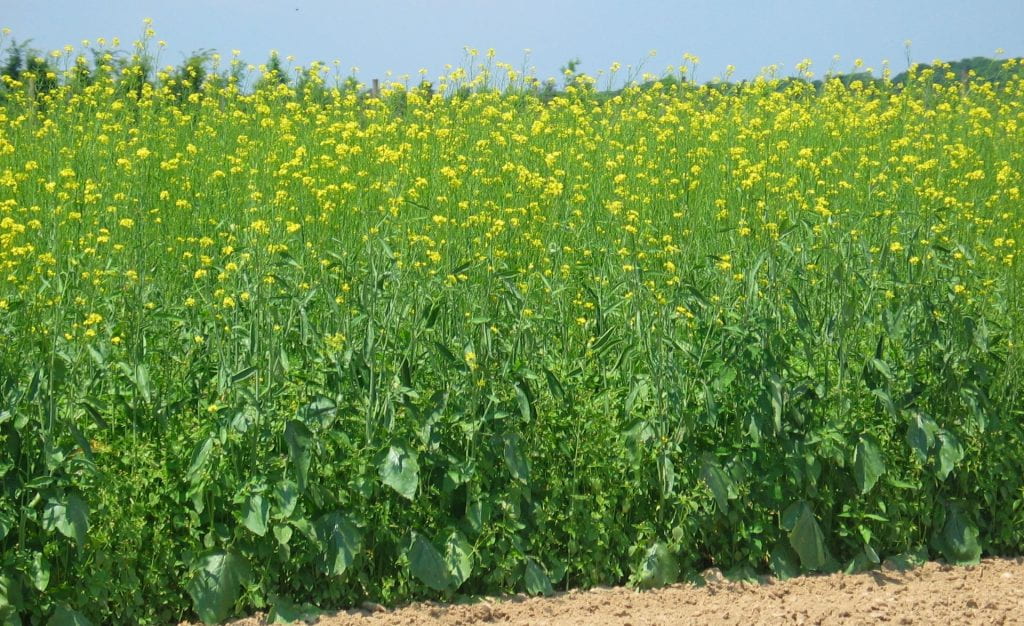

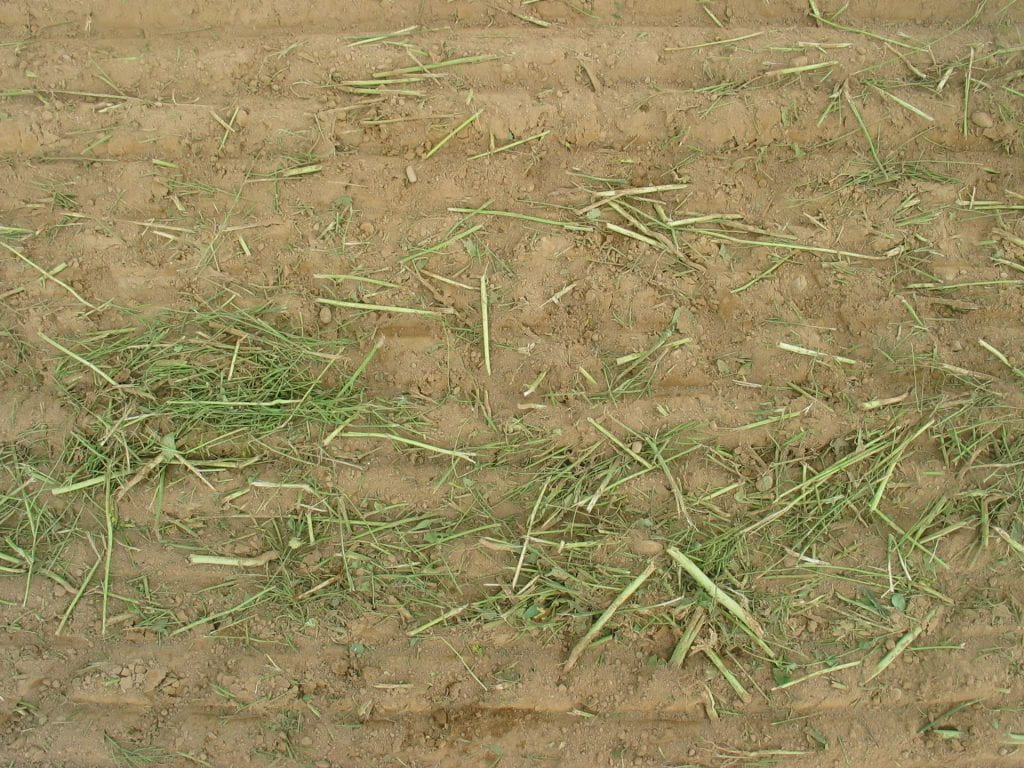

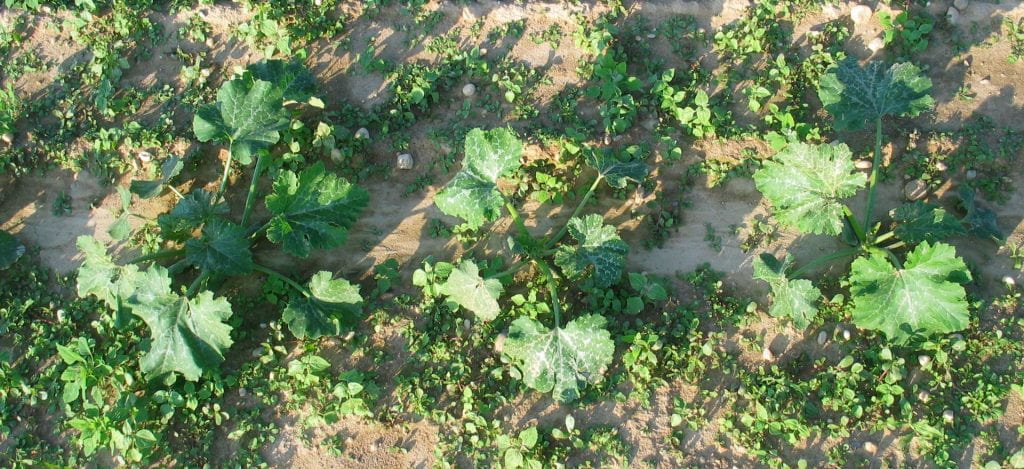
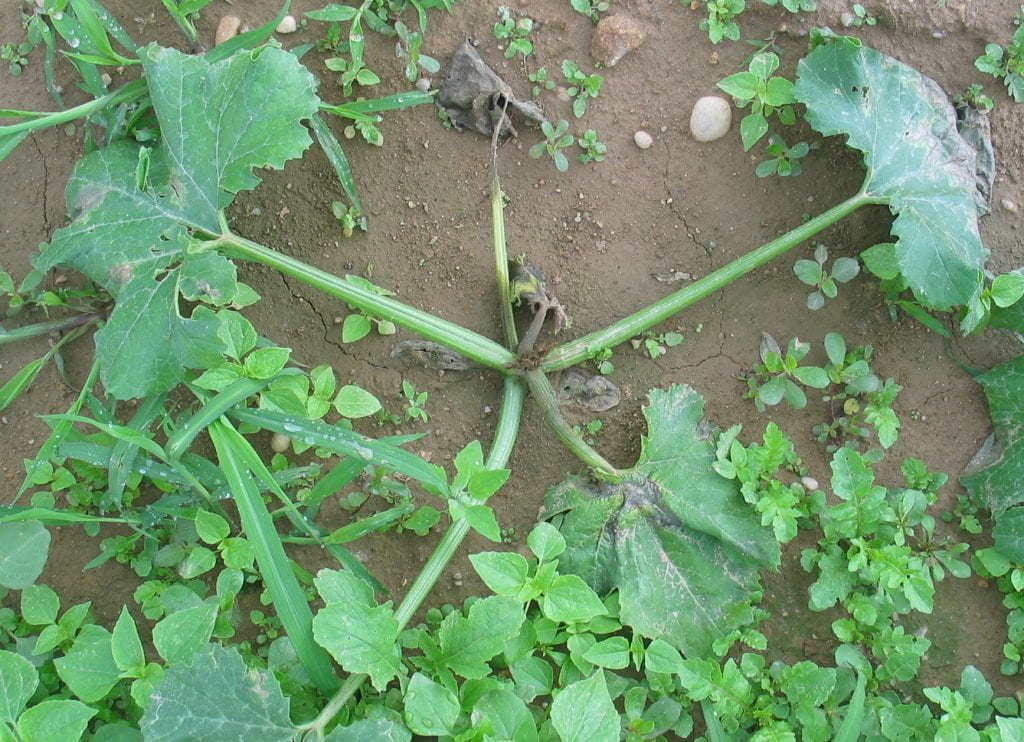
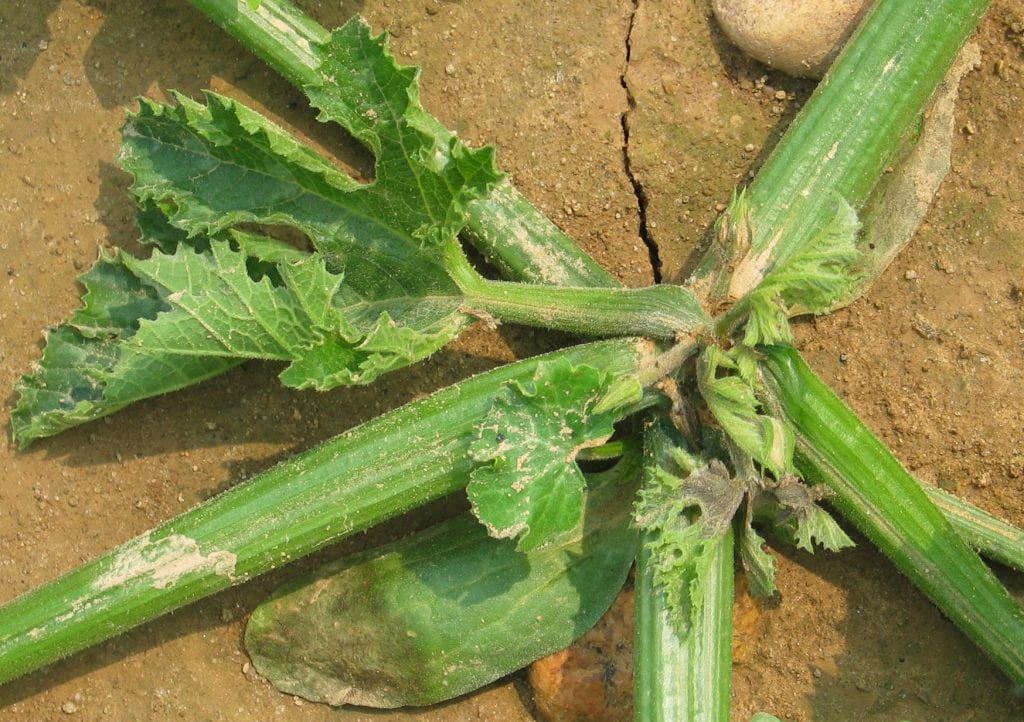
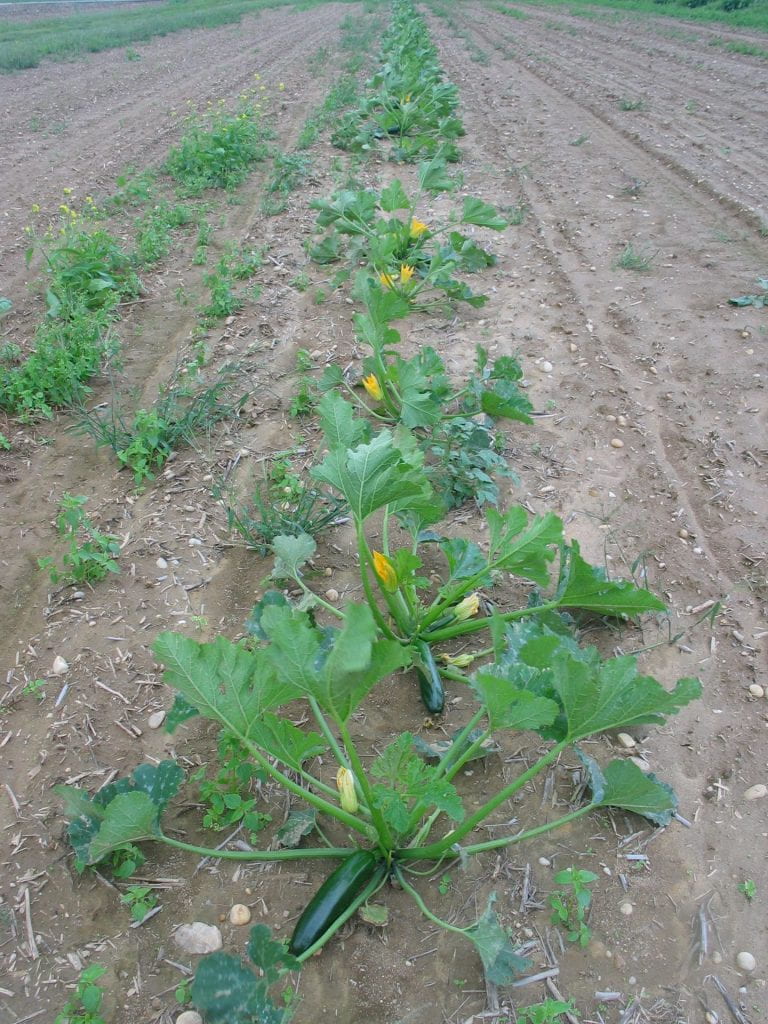
Soil Biofumigation with Mustard Cover Crops for Phytophthora Management, 2009
Investigators: S. Menasha and M. T. McGrath
The use of brassica cover crops for the management of soil-borne pests and diseases has been gaining in popularity as an organic and cost effective alternative to conventional soil fumigation especially as many conventional fumigants are being phased out for use in several fruit and vegetable crops. Biofumigation refers to the suppression of various soil-borne pests and diseases through naturally occurring compounds. All brassicas such as cabbage, kale, cauliflower, Brussel sprouts, broccoli, mustard, and turnips naturally produce glucosinolates, the compounds that make certain brassicas “hot”, and the enzyme myrosinase. Some new brassica cover crops have been developed with very high levels of glucosinolates specifically for use as a biofumigant. When plant cells are damaged such as by chopping, the glucosinolates come in contact with the enzyme myrosinase and produce the natural gas isothiocyanate (ITC). ITC is similar to the active ingredient in Metham Sodium or the conventional fumigant Vapam (a.i. Methyl ITC). In addition to the soil biofumigation benefits, brassica cover crops are ideal for adding organic matter to the soil and improving many soil health related characteristics due to the large quantity of “green” or fresh biomass produced and incorporated into the system.
A trial was established at LIHREC to evaluate the biofumigation effects of a mustard cover crop on the management of the soil-borne pathogen Phytophthora capsici, the casual agent for the destructive disease known as Phytophthora blight, in acorn squash and determine any benefits related to production and quality of the squash from the green biomass additions. Treatments consisted of a mustard cover crop, variety; ‘Caliente 199’, compared to a no mustard control. The mustard cover crop was grown at three different nitrogen (N) rates per acre (A); 0 lbs, 50 lbs, and 100 lbs N/A to determine any effects on biomass production and subsequent biofumigant ability. Acorn squash was either direct seeded or transplanted at one week intervals following incorporation to evaluate any suppressive effects the mustard cover crop may have on crop germination and/or growth. The experiment was established into a known Phytophthora capsici infested field and arranged as a randomized complete block design with 4 replications. Treatment plots were 50 ft long by 1 row wide. Rows were spaced on 68” centers and ‘Royal Ace’ acorn squash was either direct seeded or transplanted 2’ apart within the row.
On March 25 the field was plowed and fertilizer was broadcast onto the appropriate plots at the different nitrogen rates per acre (0 lbs, 50 lbs, and 100 lbs). The mustard was then no-till drilled into plots at a rate of 10 lbs/A. The control, or no mustard plots, did not receive any fertilizer at this time. First bloom occurred on May 25 and plants were approximately 1.5’ tall. The mustard was allowed to grow for an additional 4 weeks before it was incorporated on June 29; plants were about 5.5’ tall. The additional time allowed for growth before incorporation is important because the mustard will likely double in height after flowering; vertical growth will stop at plant maturity. This is significant as we need as much biomass as possible for the organic matter benefits but also to increase the biofumigant potential. It takes approximately 6 weeks from flowering until viable seed is produced which provides the grower with a large window to achieve the latter. Cover crop height measurements were taken 3 times during growth and biomass information was collected just prior to incorporation.
On June 29, the crop was flail chopped for maximum cell destruction. Immediately after, the residue was incorporated to a depth of 4-6” with a roto-tiller and a coulter packer followed in order to seal the soil surface to trap in the ITC gas. The plots were then irrigated to add moisture and to further seal the soil surface. It is critical to incorporate the crop as soon as possible after chopping as up to 80% of the ITC gas will be lost in 20 minutes. Soil moisture at incorporation is also essential for optimal biofumigation effects and can be achieved through either irrigation or incorporation around a rain event. On July 14, ‘Royal Ace’ acorn squash was either direct seeded or transplanted into the field. The control, or no mustard plots, received 1000 lbs 10-10-10 prior to planting as did the mustard plots that received no fertilizer at the time of cover crop establishment. The mustard plots that received 50 lbs N/A in the form of 10-10-10 at cover crop establishment received an additional 500 lbs 10-10-10 just prior to squash planting and mustard plots that received 100 lbs N/A as 10-10-10 at cover crop establishment received an additional 200 lbs/A 10-10-10 just prior to squash planting. Successive plantings occurred 1 and 2 weeks after July 14 on July 20 and July 27, respectively. Insects and weeds were managed according to Cornell guidelines and fungicides were sprayed to control for powdery mildew and downy mildew and did not include any treatments for Phytophthora control. Supplemental irrigation was provided when needed to achieve approximately 1” of water per week. Data on Phytophthora blight occurrence was recorded multiple times throughout the growing season. Fruit was harvested from the center 20 feet of each plot row on October 26. Yield and brix levels (% soluble solids) of the acorn squash were recorded for each treatment.
Results from the trial show that nitrogen fertilizer rate has a significant effect on mustard crop height. Mustard plants were significantly taller at 100 lbs N/A and 50 lbs N/A compared to the no fertilizer treatment at the time of flowering. One week later on June 2, mustard plants were significantly taller at 100 lbs N/A compared to the 50 and 0 lbs N/A treatments and furthermore, mustard at the 50 lbs N/A treatment were significantly taller than mustard grown at 0 lbs N/A. On June 15, just prior to incorporation, fertilizer rate did not significantly affect mustard crop height but the numeric trend was similar to the other sampling dates with the tallest plants at 100 lbs N/A followed by 50 lbs N/A and then 0 lbs N/A. In combination, aboveground biomass production of the mustard crop was also significantly affected by fertilizer rate with significantly more aboveground biomass (fresh and dry weight) produced at 100 lbs N/A compared to 50 and 0 lbs N/A and significantly more aboveground biomass produced at 50 lbs N/A compared to 0 lbs N/A. Therefore, although height differences were not significant prior to incorporation, aboveground biomass was and was likely due to more leaf area achieved at higher nitrogen rates. More leaf area results in better weed control. Visual inspection of plots supported the latter theory.
Marketable yield of ‘Royal Ace’ was significantly increased with the use of a mustard cover crop grown with no fertilizer over the no mustard treatment; both of which received 1000 lbs/A 10-10-10 fertilizer applied at the time the squash was planted. There was no difference in marketable yield between the no mustard control and the mustard cover crop treatments grown with 50 or 100 lbs N/A and received 500 and 200 lbs/A 10-10-10 fertilizer at squash planting, respectively. Furthermore, marketable yields among the mustard cover crop treatments grown at the three different fertilizer rates were not significantly different from each other. The slight increase in yield in the mustard cover crop treatment at 1000 lbs 10-10-10 at the time of squash planting over the other mustard fertilizer treatments is likely due to more plant available N to meet crop demands where much of the N in the other mustard cover crop plots which received much less N at the time of squash planting but more N at time of cover crop establishment may have still been tied up. Brix levels were also significantly influenced by the use of a mustard cover crop with the mustard plots receiving 1000 lbs and 500 lbs/A 10-10-10 fertilizer at squash planting having significantly higher brix levels than the no mustard control. Squash brix levels from the mustard treatment which received 200 lbs/A 10-10-10 fertilizer at squash planting did not significantly differ from the other mustard treatments or from the no mustard treatment. There was no significant affects from transplanting or direct-seeding on yield, brix, or Phytophthora blight occurrence. Thus, the data was pooled.
The number of Phytophthora infected fruit was not significantly influenced by treatment. However, there was a numeric difference among the treatments evaluated with the no mustard treatment having the highest number of Phytophthora infected fruit. Furthermore, although the mustard treatments did have Phytophthora infected fruit, the disease first appeared in the no mustard treatment plots and possible movement of the spores from these infected fruits may have contributed to the number of infected fruits we observed in adjacent plots. Regardless, a numeric decrease in the number of Phytophthora infected fruit was observed with the use of a mustard cover crop and significant reductions may be achieved after multiple seasons of implementing biofumigant cover crops resulting from a cumulative effect of the biofumigant on soil-borne pathogens.
In conclusion, the use of ‘Caliente 199’ mustard cover crop as a potential biofumigant to manage the soil-borne pathogen Phytophthora capsici, causal agent of Phytophthora blight of cucurbits, has shown to be a promising cultural practice. Although in the first year of this study we did not see significant reductions in the number of Phytophthora infected fruit among the mustard and no mustard treatments, a numeric reduction was achieved from the mustard treatments. In addition, ‘Caliente 199’ significantly increased marketable yield and brix levels found in the subsequent crop of acorn squash which can be credited to the green organic matter additions supplied from the mustard crop and/or to the biofumigant ability of the mustard. To close, significantly more aboveground biomass is produced when mustard is grown using a rate of 100 lbs N/A compared to 50 lbs or 0 lbs N/A. Although height differences were not significant at the time of incorporation for the different nitrogen rate treatments, aboveground biomass production was, suggesting that a greater leaf area is achieved with a higher nitrogen rate contributing to better weed control and possibly better biofumigant ability. This study has shown the promise of using mustard cover crops for increased yield, crop quality, and improved management of the soil-borne pathogen Phytophthora capsici in winter squash but further research is needed to confirm these results.
Soil Biofumigation with Mustard Cover Crops for Phytophthora Management, 2010
Investigators: S. Menasha and M. T. McGrath
A replicated trial conducted in 2009 at LIHREC showed promise in utilizing mustard cover crops for the management of soil-borne diseases in cucurbit crops. In addition to the soil biofumigation benefits, mustard cover crops add fresh organic matter to the soil which in turn improves many soil health quality characteristics and soil biological activity due to the green plant material incorporated into the system.
In 2010, the trial was repeated at LIHREC to re-evaluate the biofumigation effects of a mustard cover crop on the management of the soil-borne pathogen Phytophthora capsici in acorn squash. In addition to any biofumigation effects on the squash crop, any benefits related to squash production and quality were determined. Treatments included a mustard cover crop, variety; ‘Caliente 199’, compared to a no mustard control. The mustard cover crop was grown at three different nitrogen (N) rates per acre (A); 0 lbs, 50 lbs, and 100 lbs N/A to determine any effects on biomass production and subsequent biofumigant ability. ‘Royal Ace’ acorn squash was direct seeded into each treatment plot two weeks post-incorporation of the mustard cover crop. A two-week interval was provided to allow time for the biofumigation process to occur as well as to avoid any suppressive effects the biofumigant may have on the emergence and growth of the acorn squash. No suppressive effects were observed on squash germination or growth when seeded 7 days after incorporation in 2009 but it was felt that seeding 10-14 days after incorporation would provide a longer window for the biofumigation process to take affect achieving greater benefits. The experiment was established into a known Phytophthora capsici infested field and was arranged as a randomized complete block design with 4 replications. Treatment plots were 50 ft long by 2 rows wide. Rows were spaced on 68” centers and ‘Royal Ace’ acorn squash was direct-seeded 2 ft apart within the row. Transplants were not included in 2010 as no differences were observed in 2009 between transplant and direct-seeded treatments in regard to growth, yield, and crop quality and most growers are direct-seeding their winter squash.
The field was plowed on April 7. Fertilizer was broadcast on April 8 onto corresponding plots at 3 different nitrogen rates per acre; 0 lbs, 50 lbs, and 100 lbs in preparation for seeding the mustard cover crop. Treatment plots were established in the same field and in the same locations within the field as in 2009. ‘Caliente 199’ mustard seed was no-till drilled into plots at a rate of 10 lbs/A on April 8. The control, or no mustard treatment, did not receive any fertilizer at this time. First bloom occurred on May 28 and plants were approximately 1.2’ tall. The mustard was allowed to grow for an additional 2 weeks before it was flail chopped and incorporated with a roto-tiller on June 14; plants were about 4.5’ to 5.0’ tall. The additional 2 weeks of growth after flowering and before incorporation is critical as the mustard will likely double in height during this time. Increased biomass translates to improved biofumigant potential and greater returns from organic matter additions. Viable seed is produced about 6 weeks after flowering providing the grower a large window of opportunity before a weed problem is introduced. Mustard height measures were taken 4 times and aboveground biomass was collected just prior to incorporation by cutting the mustard plants at the soil line within a 1’ x 1’ square and drying the plant material before weighing.
On June 14, the mustard crop was flail chopped for maximum cell destruction. Immediately after, plant residue was incorporated to a depth of 4-6” with a roto-tiller and a coulter packer was driven over the field to seal the soil surface and trap in the ITC gas produced. The plots were then overhead irrigated to add moisture and to further seal the soil surface. It is critical to incorporate the crop as soon as possible after chopping as up to 80% of the ITC gas can be lost in as little as 20 minutes. Soil moisture is also essential for the biofumigation process and can be achieved either with irrigation or through incorporation around a rain event. ‘Royal Ace’ acorn squash was direct seeded into treatment plots on July 1. The control, or no mustard plots and the mustard treatment grown at a rate of 0 lbs N/A, received 1000 lbs/A 10-10-10 fertilizer prior to planting. The mustard treatment grown at a rate of 50 lbs N/A (10-10-10) received an additional 500 lbs/A 10-10-10 fertilizer and mustard treatments grown with 1000 lbs N/A (10-10-10) received an additional 300 lbs/A 10-10-10 fertilizer prior to seeding squash. Insects and weeds were managed according to Cornell guidelines and fungicides were sprayed to control for powdery mildew and downy mildew but did not include any activity for Phytophthora blight management. Supplemental irrigation was provided when needed to equal approximately 1” of water per week. Data on Phytophthora occurrence was recorded multiple times throughout the growing season. Fruit were harvested from the center 20 feet of each row on October 21. Yield and brix levels (% soluble solids) were recorded and analyzed.
Results show that nitrogen fertilizer rate did have a significant effect on mustard cover crop height. Mustard plants were significantly taller when grown at a rate of 100 lbs N/A compared to plants grown at 50 lbs N/A which were significantly taller than plants grown at a rate of 0 lbs N/A on all sampling dates except on June 3. In combination, aboveground biomass production of the mustard crop was also significantly affected by fertilizer rate with significantly more aboveground biomass produced at 100 lbs N/A compared to 50 lbs N/A and biomass produced at 50 lbs N/A was significantly more compared to 0 lbs N/A. Similar results were observed in 2009 where mustard grown at 100 lbs N/A produced significantly more aboveground biomass compared to mustard grown at 50 and 0 lbs N/A.
Marketable yields of ‘Royal Ace’ acorn squash were not significantly affected by treatment as in 2009. However, marketable yields were numerically higher in all three mustard treatments compared to the no mustard control. The number of Phytophthora infected fruit was significantly influenced by treatment. There were significantly more Phytophthora infected fruit in the no mustard treatment compared to the mustard treatments grown at a rate of 50 and 100 lbs N/A. The mustard treatment grown at a rate 0 lbs N/A did not statistically differ from any of the other treatments evaluated. Although not significant, the number of Phytophthora infected fruit observed in 2009 was reduced in the mustard treatments compared to the no mustard control. The mustard treatments grown at a rate of 50 and 100 lbs N/A produced significantly more biomass and thus potentially had greater biofumigant ability contributing to the significantly lower number of Phytophthora infected fruit. A cumulative effect of the biofumigation process may also be contributing to the significant reduction in Phytophthora infected fruit as 2010 was the second year plots were biofumigated. Fruit quality was also improved with the use of a mustard cover crop. Brix levels (% soluble solids) of the acorn squash were significantly greater in the mustard treatment grown at a rate of 100 lbs N/A compared to the no mustard control. However, the mustard treatments grown at a rate of 0 and 50 lbs N/A did not statistically differ from the no mustard control. Similar results were achieved in 2009 where brix levels in the acorn squash were increased with the use of mustard cover crops.
In conclusion, two years of trial data have supported the use of ‘Caliente 199’ mustard cover crop as a potential biofumigant to improve management the soil-borne pathogen Phytophthora capsici in cucurbits. In both years of the study, acorn squash yield was increased with the use of a mustard cover crop and this increase was as high as 36% in 2009 and 30% in 2010. The number of Phytophthora infected fruit was significantly decreased in 2010 with the use of a mustard cover crop grown at both rates of 50 and 100 lbs N/A and although not significant, reduced the number of Phytophthora infected fruit in 2009 from an average of 5.3 infected fruit in the no mustard treatment to as low as 1.5 infected fruit in the mustard treatment grown at a rate of 100 lbs N/A. In both years, acorn squash brix levels were significantly increased with the use of a mustard cover crop improving overall crop quality.
Aboveground biomass production (dry weight) of the mustard cover crop increased significantly with increasing N rate per acre in both years of the study. The increase in biomass production can be correlated to the increased brix levels and decreased incidence of Phytophthora and in 2010, can further be correlated to the potential cumulative effects of fresh organic matter and biofumigation. Thus, in order to obtain the greatest biomass for increased biofumigation potential, more leaf area for weed suppression, and more organic matter for improved soil and crop quality, ‘Caliente 199’ should be grown at 100 lbs N/A. However, in some instances, the above measures will not be significantly decreased when the cover crop is grown at 50 lbs N/A as in 2009. But numerically there is a consistent advantage obtained in the above measures when the cover crop is grown using 100 lbs N/A. Data supports the use of mustard cover crops as a beneficial tool growers can use as part of an integrated program to manage Phytophthora in cucurbit crops. Biofumigation should not be solely relied upon for crop protection as different seasons and growing conditions may influence biofumigant potential. Mustard cover crops are also a great source of organic matter which over time can have a significant positive impact on soil health and quality and thus further reduce the potential for Phytophthora infection.
Biofumigant Mustard Cover Crop and Mustard Meal Product Examined for Managing Phytophthora Blight, 2011
Investigators: M. T. McGrath and L. Hunsberger
An observational, non-replicated study was conducted to examine BioFence, a mustard meal product, and three varieties of mustard developed for use as biofumigant cover crops. One of the varieties, Caliente 199, was demonstrated to be effective for managing Phytophthora blight through previous projects at LIHREC. Idagold and PacificGold were also grown. If effective, a mustard meal product would be a good alternative when there is not enough time to grow a cover crop before it is time to plant the crop. BioFence (Volunteer Ag Products, LLC.) currently is marketed as an organic fertilizer (6-2-0).
The study was done in a research field dedicated to work on Phytophthora blight. Fertilizer (38-0-0) at 75 lb/A was spread on 3 May and tilled to incorporate where mustard cover crops were to be seeded, which was done on 6 May by drilling. On 30 June mustard was flail-chopped, roto-tilled to incorporate, then irrigated to seal the soil surface. Fertilizer (10-10-10) at 500 lb/A was spread on 17 July over rows where mustard was incorporated to augment fertility from the cover crop. BioFence was broadcast at 2000 lb/A (120 lb/A N) on 17 July, incorporated by disking, then irrigated to activate. In addition to the 3 sections with mustard cover crop and the section with BioFence, there was a section where Caliente 199 was grown in 2010 and a non-treated section. To ensure the pathogen was present, cucumber fruit that had been inoculated with the pathogen (Phytophthora capsici) were placed in each section of the field just before the treatment was incorporated. All sections were seeded to ‘Royal Ace PM’ acorn squash on 22 July.
Unusually intensive rain events created exceptionally favorable conditions for Phytophthora blight throughout LI in 2011, resulting in high incidence of blight in this study as well as in commercial crops. Rainfall amounts for the study site were 2.33 in. on 28 August (Hurricane Irene), 1.32 in. on 6 September, 1.06 in. on 7 September, and 0.98 in. on 8 September. When soil is saturated, Phytophthora capsici produces and releases spores that are capable of moving to host plants in a directed fashion. Phytophthora blight developed in the research field after this period. Incidence was high when assessed on 15 September. Diseases caused by soil-borne pathogens generally, and this disease particularly, can be very difficult to suppress under conditions highly favorable for their development. Therefore, lack of detectable suppression of Phytophthora blight with any treatment in 2011 was not surprising.
Demonstration of Integrated Management Program for Phytophthora Blight in Pumpkin, 2012
Investigators: M. T. McGrath and K. LaMarsh
The goal of this study was to answer a question many growers asked the previous fall: can pumpkin be grown successfully the year after a severe outbreak of Phytophthora blight. Many growers on Long Island, and elsewhere is the Northeast, endured extensive losses to this disease especially in Halloween pumpkins due to conditions being especially favorable for this disease during a prolonged period of wet weather with intensive rain brought on by Hurricane Irene followed by Tropical Storm Lee. Following these storms in 2011, the research field used for this study had a high incidence of pumpkin fruit with Phytophthora fruit rot throughout the field.
The management program implemented included mustard biofumigation, subsoiling between rows to improve drainage, weekly applying fungicides with targeted activity for oomycete pathogens, and destroying the first plants affected. Fertilizer (10-10-10) was spread at 400 lb/A then incorporated on 30 March. Mustard variety Caliente 199 was seeded at 10 lb/A on 3 April. Plants had emerged by 13 April and started flowering by 21 May. On 12 June the mustard was flail chopped, immediately disked to incorporate, and then a cultipacker was used to seal the surface. This was an ideal day for this step because there was a high probability of rain occurring afterwards to provide the water needed for the biofumigation. Total of 1.5 inches of rain fell over night and during the day on 13 June. On 3 July the ground was lightly disked, then seeds of pumpkin variety ‘Magic Lantern’ were sown at approximately 24-in. plant spacing within rows with a vacuum seeder. There were three 500-ft rows spaced 68-in. apart. The seeder applied fertilizer in two bands about 2 in. away from the seed. Controlled release fertilizer (15-5-15) was used at 675 lb/A. The herbicides Strategy (3 pt/A), Curbit EC 1 pt/A, and Sandea (0.5 oz/A) were applied over the entire plot area on 5 July, which was followed by irrigation to activate. On 24 July the soil between pumpkin rows was subsoiled. The following fungicides (listed alphabetically) were applied for Phytophthora blight: Curzate 60 DF (5 oz/A) on 31 July; Forum 4.16SC (6 oz/A) on 7 September and 21 September; Presidio (4 fl oz/A) on 31 July, 17 August, 14 September, and 21 September; ProPhyt (2 qts/A) on 18 July; Ranman 400 SC (2.75 fl oz/A) on 31 July and 24 August; and Revus (8 oz/A) on 8 August and 1 September. Seven applications were made. A fungicide application could not be made before a 2.5 in. rain event on 28 July because of sprayer malfunction. Rain also fell on 20 and 24 July. Symptoms of blight were observed on 30 July in another pumpkin planting at LIHREC, therefore several oomycete fungicides were applied together on 31 July before resuming a 7-day schedule alternating among individual products. Beginning with the application on 8 August, Bravo Ultrex (1.8 lb/A) and/or a copper fungicide were also included as well as a fungicide with targeted activity for powdery mildew: Quintec (6 fl oz/A) on 8 August, 24 August, and 7 September; Rally (5 oz/A) on 17 August and 14 September; and Pristine (18.5 oz/A) on 1 September.
Symptoms of blight were first observed on 16 August in the low end of the field. Affected plants plus a healthy border area were disked on 24 August. A few affected fruit were observed near this area and in the center of the field during September. These fruit were not removed. Of the 1489 fruit counted on 17 October, 91.1% were good with no signs of rot due to Phytophthora or another cause. The integrated program was considered successful. Excellent control of powdery mildew was achieved with the fungicides applied for this disease. Very few symptoms were observed on 19 September. Average severity on upper and lower leaf surfaces was less than 1%.
More information/prepared by:
Margaret Tuttle McGrath
Associate Professor
Long Island Horticultural Research and Extension Center (LIHREC)
Plant Pathology and Plant-Microbe Biology Section
School of Integrative Plant Science
College of Agriculture and Life Sciences
Cornell University
mtm3@cornell.edu


